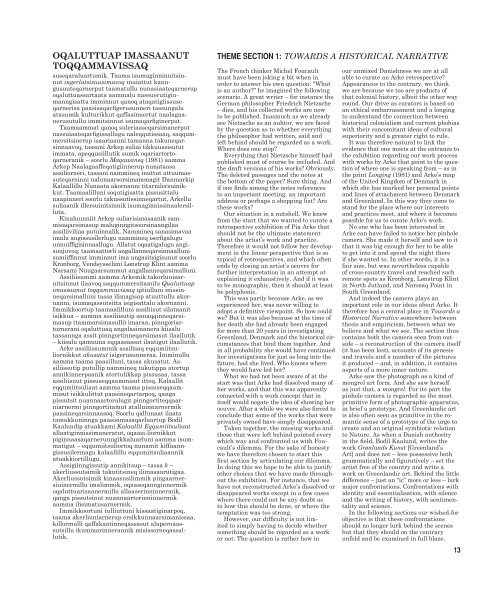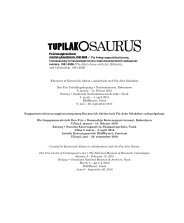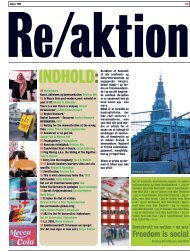tupilakosaurus - Print matters!
tupilakosaurus - Print matters!
tupilakosaurus - Print matters!
You also want an ePaper? Increase the reach of your titles
YUMPU automatically turns print PDFs into web optimized ePapers that Google loves.
OQALUTTUAP IMASSAANUT<br />
TOQQAMMAVISSAQ<br />
suseqaraluartumik. Taama isumaginninnitsinnut<br />
ingerlatsisuusimavoq inuiattut kanngusuuteqarnerput<br />
taamatullu nunasiaateqarnerup<br />
oqaluttuassartaata aammalu nassuerutigiumanngisatta<br />
imminnut qanoq ataqatigiissuseqarnerisa<br />
paasisaqarfigerusunneri tassungalu<br />
atasumik kulturikkut qaffasinnertut naalagaanerusutullu<br />
immitsinnut isumaqarfiginerput.<br />
Taamaammat qanoq suleriaaseqarsimanerput<br />
nassuiaateqarfigissallugu naleqqutissaaq, saqqummersitsinerup<br />
isaariaanni tamanna takuneqarsinnaavoq,<br />
tassani Arkep suliai tikkuussisutut<br />
immata, apeqqusiillutik sumik oqariartortoqarneranik<br />
– soorlu Maqaasineq (1981) aamma<br />
Arkep Naalagaaffeqatigiinnerup nunataasa<br />
assiliorneri, tassani nammineq inuttut attuumassuteqarninni<br />
nalunaarsorsimammagit Danmarkip<br />
Kalaallillu Nunaata akornanni titarnilersuinikkut.<br />
Taamaalilluni soqutigisatta pissusittalu<br />
naapinneri soorlu takussutissinneqartut, Arkellu<br />
suliaanik illersuinitsinnik isumaginnissinaalersilluta.<br />
Kinaluunniit Arkep suliarisimasaanik sammisaqarsimasup<br />
maluginngitsoorsinaangilaa<br />
assiliiviliaa putuinnalik. Nammineq sanasimavaa<br />
imalu angissusilerlugu nammineq iserfigalugu<br />
unnuiffigisinnaallugu. Allatut oqaatigalugu angisuujuvoq;<br />
taamaattorli angallanneqarsinnaalluni<br />
sumiiffinnut imminnut ima ungasitsigisunut soorlu<br />
Kronborg, Vendsysselimi Lønstrup Klint aamma<br />
Narsami Nuugaarsummut angallanneqarsimalluni.<br />
Assiliisummi aamma Arkemik takorluuisarnitsinnut<br />
ilaavoq saqqummersitamilu Qualuttuap<br />
imassaanut toqqammavissaq qitiulluni inissinneqarsimalluni<br />
tassa ilimagisap atuuttullu akornanni,<br />
isumaqassutsitta isigisattalu akornanni.<br />
Immikkoortup taamaalilluni assiliisut silataanit<br />
isikkua – aamma assiliisutip sanaqqinneqarsimasup<br />
(tammarsimasulli) imaraa, pinngoriartornerani<br />
oqaluttuaq angalasimanera kiisalu<br />
tassannga assit pinngortinneqarsimasut ilaallutik<br />
– kiisalu qamuuna eqqaasassat ilaatigut ilaallutik.<br />
Arke assiliissummik assilisaq eqqumiitsuliornikkut<br />
akusatut isigerusunneraa. Imminullu<br />
aamma taama paasilluni, tassa akusatut. Assiliissutip<br />
putullip nammineq takutippa atortup<br />
annikinnerpaanik atortulikkap pissusaa, tassa<br />
assiliisuut pissuseqqaammisut ittoq. Kalaallit<br />
eqqumiitsuliaat aamma taama pissuseqqaammisut<br />
isikkulittut paasineqartarpoq, qanga<br />
pissutsit nuannaartoralugit pinngortiteqqaarniarnermi<br />
pinngortitamut atalluinnarnermik<br />
paasineqarsinnaasoq. Soorlu qallunaat ilaata<br />
tamakkuninnga paasisimasaqarluartup Bodil<br />
Kaalundip atuakkami Kalaallit Eqqumiitsuliaat<br />
allaatiginnissimaneratut, oqaasi-liornikkut<br />
piginnaasaqarnerunngikkaluarluni aamma isummatigut<br />
– eqqumiitsuliortoq nunamit kiffaanngissusilermagu<br />
kalaallillu eqqumiitsuliaannik<br />
atuakkiortillugu.<br />
Assigiinngissutip annikitsup – tassa k –<br />
akerliussutsimik takutitsineq ilimasaarutigaa.<br />
Akerliussutsimik kinaasusilimmik pingaarnersiuinermillu<br />
imalimmik, oqaaseqannginnermik<br />
oqaluttuarisaanermillu allaaserinninnermik,<br />
qanga pissutsinut nuannaartorinninnermik<br />
aamma ilisimatusarnermik.<br />
Immikkoortuni tulliuttuni kissaatiginarpoq,<br />
taama akerliuniarnerup ersikkunnaarsimanissaa,<br />
killormulli qaffakaatinneqassasut alapernaassutsillu<br />
ikummarinnerannik misissorneqassallutik.<br />
THEME SECTION 1: TOWARDS A HISTORICAL NARRATIVE<br />
The French thinker Michel Foucault<br />
must have been joking a bit when in<br />
order to answer his own question: “What<br />
is an author?” he imagined the following<br />
scenario. A great writer – for instance the<br />
German philosopher Friedrich Nietzsche<br />
– dies, and his collected works are now<br />
to be published. Inasmuch as we already<br />
see Nietzsche as an auhtor, we are faced<br />
by the question as to whether everything<br />
the philosopher had written, said and<br />
left behind should be regarded as a work.<br />
Where does one stop?<br />
Everything that Nietzsche himself had<br />
published must of course be included. And<br />
the draft versions of his works? Obviously.<br />
The deleted passages and the notes at<br />
the bottom of the paper? Sure thing. And<br />
if one finds among the notes references<br />
to an important meeting, an important<br />
address or perhaps a shopping list? Are<br />
these works?<br />
Our situation in a nutshell. We knew<br />
from the start that we wanted to curate a<br />
retrospective exhibition of Pia Arke that<br />
should not be the ultimate statement<br />
about the artist’s work and practice.<br />
Therefore it would not follow her development<br />
in the linear perspective that is so<br />
typical of retrospectives, and which often<br />
ends by closing an artist’s oeuvre for<br />
further interpretation in an attempt at<br />
explaining it exhaustively. And if it was<br />
to be monographic, then it should at least<br />
be polyphonic.<br />
This was partly because Arke, as we<br />
experienced her, was never willing to<br />
adopt a definitive viewpoint. So how could<br />
we? But it was also because at the time of<br />
her death she had already been engaged<br />
for more than 20 years in investigating<br />
Greenland, Denmark and the historical circumstances<br />
that bind them together. And<br />
in all probability she would have continued<br />
her investigations for just as long into the<br />
future, had she lived. Who knows where<br />
they would have led her?<br />
What we had not been aware of at the<br />
start was that Arke had dissolved many of<br />
her works, and that this was apparently<br />
connected with a work concept that in<br />
itself would negate the idea of showing her<br />
oeuvre. After a while we were also forced to<br />
conclude that some of the works that were<br />
privately owned have simply disappeared.<br />
Taken together, the missing works and<br />
those that were left behind pointed every<br />
which way and confronted us with Foucault’s<br />
dilemma. For the sake of honesty<br />
we have therefore chosen to start this<br />
first section by articulating our dilemma.<br />
In doing this we hope to be able to justify<br />
other choices that we have made throughout<br />
the exhibition. For instance, that we<br />
have not reconstructed Arke’s dissolved or<br />
disappeared works except in a few cases<br />
where there could not be any doubt as<br />
to how this should be done, or where the<br />
temptation was too strong.<br />
However, our difficulty is not limited<br />
to simply having to decide whether<br />
something should be regarded as a work<br />
or not. The question is rather how in<br />
our unmixed Danishness we are at all<br />
able to curate an Arke retrospective?<br />
Appearances to the contrary, we think<br />
we are because we too are products of<br />
that colonial history, albeit the other way<br />
round. Our drive as curators is based on<br />
an ethical embarrassment and a longing<br />
to understand the connection between<br />
historical colonialism and current phobias<br />
with their concomitant ideas of cultural<br />
superiority and a greater right to rule.<br />
It was therefore natural to link the<br />
evidence that one meets at the entrance to<br />
the exhibition regarding our work process<br />
with works by Arke that point to the question<br />
of where one is speaking from – as in<br />
the print Longing (1981) and Arke’s map<br />
of the United Kingdom of Denmark in<br />
which she has marked her personal points<br />
and lines of attachment between Denmark<br />
and Greenland. In this way they come to<br />
stand for the place where our interests<br />
and practices meet, and where it becomes<br />
possible for us to curate Arke’s work.<br />
No one who has been interested in<br />
Arke can have failed to notice her pinhole<br />
camera. She made it herself and saw to it<br />
that it was big enough for her to be able<br />
to get into it and spend the night there<br />
if she wanted to. In other words, it is a<br />
fair size, but was nevertheless capable<br />
of cross-country travel and reached such<br />
remote spots as Kronborg, Lønstrup Klint<br />
in North Jutland, and Narssaq Point in<br />
South Greenland.<br />
And indeed the camera plays an<br />
important role in our ideas about Arke. It<br />
therefore has a central place in Towards a<br />
Historical Narrative somewhere between<br />
thesis and empiricism, between what we<br />
believe and what we see. The section thus<br />
contains both the camera seen from outside<br />
– a reconstruction of the camera itself<br />
(it has been lost), accounts of its genesis<br />
and travels and a number of the pictures<br />
it produced – and, in addition, it contains<br />
aspects of a more inner nature.<br />
Arke saw the photograph as a kind of<br />
mongrel art form. And she saw herself<br />
as just that, a mongrel. For its part the<br />
pinhole camera is regarded as the most<br />
primitive form of photographic apparatus,<br />
in brief a prototype. And Greenlandic art<br />
is also often seen as primitive in the romantic<br />
sense of a prototype of the urge to<br />
create and an original symbiotic relation<br />
to Nature. As when a Danish authority<br />
in the field, Bodil Kaalund, writes the<br />
work Grønlands Kunst [Greenland’s<br />
Art] and does not – less possessive both<br />
grammatically and figuratively – set the<br />
artist free of the country and write a<br />
work on Greenlandic art. Behind the little<br />
difference – just an “ic” more or less – lurk<br />
major confrontations. Confrontations with<br />
identity and essentialisation, with silence<br />
and the writing of history, with sentimentality<br />
and science.<br />
In the following sections our wished-for<br />
objective is that these confrontations<br />
should no longer lurk behind the scenes<br />
but that they should on the contrary<br />
unfold and be examined in full blaze.<br />
13




